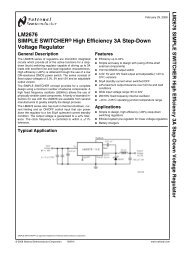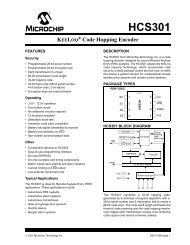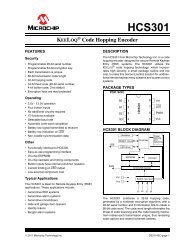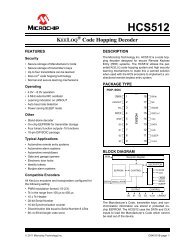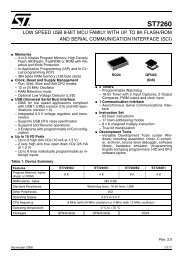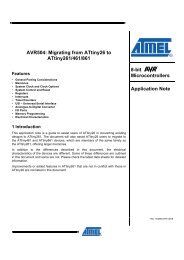dsPIC30F2010 Data Sheet - Microchip
dsPIC30F2010 Data Sheet - Microchip
dsPIC30F2010 Data Sheet - Microchip
Create successful ePaper yourself
Turn your PDF publications into a flip-book with our unique Google optimized e-Paper software.
<strong>dsPIC30F2010</strong><br />
6.4 RTSP Operation<br />
The dsPIC30F Flash program memory is organized<br />
into rows and panels. Each row consists of 32 instructions,<br />
or 96 bytes. Each panel consists of 128 rows, or<br />
4K x 24 instructions. RTSP allows the user to erase one<br />
row (32 instructions) at a time and to program 32<br />
instructions at one time. RTSP may be used to program<br />
multiple program memory panels, but the table pointer<br />
must be changed at each panel boundary.<br />
Each panel of program memory contains write latches<br />
that hold 32 instructions of programming data. Prior to<br />
the actual programming operation, the write data must<br />
be loaded into the panel write latches. The data to be<br />
programmed into the panel is loaded in sequential<br />
order into the write latches; instruction 0, instruction 1,<br />
etc. The instruction words loaded must always be from<br />
a 32 address boundary.<br />
The basic sequence for RTSP programming is to set up<br />
a table pointer, then do a series of TBLWT instructions<br />
to load the write latches. Programming is performed by<br />
setting the special bits in the NVMCON register. 32<br />
TBLWTL and four TBLWTH instructions are required to<br />
load the 32 instructions. If multiple panel programming<br />
is required, the table pointer needs to be changed and<br />
the next set of multiple write latches written.<br />
All of the table write operations are single word writes<br />
(2 instruction cycles), because only the table latches<br />
are written. A programming cycle is required for<br />
programming each row.<br />
The Flash program memory is readable, writable and<br />
erasable during normal operation over the entire VDD<br />
range.<br />
6.5 Control Registers<br />
The four SFRs used to read and write the program<br />
Flash memory are:<br />
• NVMCON<br />
• NVMADR<br />
• NVMADRU<br />
• NVMKEY<br />
6.5.1 NVMCON REGISTER<br />
The NVMCON register controls which blocks are to be<br />
erased, which memory type is to be programmed, and<br />
the start of the programming cycle.<br />
6.5.2 NVMADR REGISTER<br />
The NVMADR register is used to hold the lower two<br />
bytes of the effective address. The NVMADR register<br />
captures the EA of the last table instruction that<br />
has been executed and selects the row to write.<br />
6.5.3 NVMADRU REGISTER<br />
The NVMADRU register is used to hold the upper byte<br />
of the effective address. The NVMADRU register captures<br />
the EA of the last table instruction that<br />
has been executed.<br />
6.5.4 NVMKEY REGISTER<br />
NVMKEY is a write-only register that is used for write<br />
protection. To start a programming or an erase<br />
sequence, the user must consecutively write 0x55 and<br />
0xAA to the NVMKEY register. Refer to Section 6.6<br />
“Programming Operations” for further details.<br />
Note:<br />
The user can also directly write to the<br />
NVMADR and NVMADRU registers to<br />
specify a program memory address for<br />
erasing or programming.<br />
DS70118J-page 44<br />
© 2011 <strong>Microchip</strong> Technology Inc.





